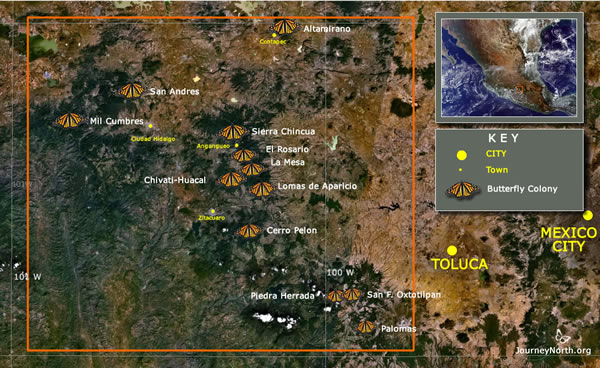Monarchs Respond to Climate Change
Monarchs roosting on oak trees in their latest roost in El Encinal, March 4, 2017.
Photo by Ellen Sharp.
| Dear Friends,
It’s our fourth and busiest Butterfly B&B season yet; my partner Joel and I have been going for several months now at full capacity, hosting people here in Macheros and taking them to see butterflies on Cerro Pelón almost every day. The last missive I got out announced the arrival of the butterflies on November 1, 2016. But after that day they kept arriving and arriving; we were still seeing them flying overhead here in the valley and along the roadways up until November 24. Many suggest that unseasonably warm temperatures in northern North America meant that a fifth generation had time to get itself launched southward. These ongoing arrivals and the subsequent increase in numbers we’ve seen here on Cerro Pelón certainly bear that observation out. On paper, population numbers are said to be down this year. On the ground, at least here at Cerro Pelón, colony size has more than doubled since last season. In the 2015-16 season, monarchs roosted above El Llano de Tres Gobernadores on about 25 trees and barely moved over the course of the season. This season, rangers first spotted discernable colonies on November 6 on the southwestern face of Cerro Pelón. At first the monarchs settled in two locations: on about ten trees in an area called Carditos and lower down the mountain on about 50-60 trees in an area known as la Cañadita. Apart from a conspicuously bigger population, the other striking feature of the season on Cerro Pelón were warm temperatures and almost daily flight activity. Forest Ranger Patricio (Pato) Moreno Rojas saw monarchs coming out of diapause to mate as early as November. By mid-January mating was even more noticeable. Tourists were invariably pleased by the spectacle of monarch mating and flight throughout the season. For us, this intensive activity was more than a little disquieting, as we wondered if there were enough nectar sources nearby to replenish the exhausted monarchs. While there were many flowers in bloom up by the small colony in Carditos, there were fewer down below where the majority of the monarchs amassed. By late December many butterflies, especially the friskier males, had noticeably emaciated abdomens. Many fell to the forest floor never to rise again. In mid-January, stands of yellow asteraceae finally burst into bloom near las Cañaditas, where they were immediately covered by hundreds of hungry monarchs. As of this writing, a handful of monarch-filled trees remain in the area of la Cañadita. The vast majority of the colony has relocated much farther downhill to a crevasse located above a meadow called El Aserradero by our village (and Las Canoas by our neighbors across the state line). The rangers named this group of trees where the new roosts have formed El Encinal, because it is mostly made up of encinos, or oak trees. So much for the idea that monarchs prefer oyamel fir trees. Unlike the evergreen vistas of the other three sanctuaries open to the public, Cerro Pelón boasts diverse foliage, and the monarchs make use of all of it. The monarchs began this population movement on February 25 and had mostly completed it by the first few days of March. But some butterflies didn’t stop at the new location. Citizen-scientist Darlene Burgess, who spent the afternoon of March 4 relaxing in our yard, sighted about 200 monarchs flying purposely to the west. Others have reported seeing a handful engaged in decidedly directional flight along the road that connects Macheros to Zitácuaro. The monarchs it seems have started a slow, staggered departure. Cooler temperatures and cloudier skies since March 5 have put the return migration on pause for the time being. But overall higher temperatures have left us asking if our colony will stay with us until the March 20 equinox as it has in seasons past. Dr. Ellen Sharp Both located at the entry of the Cerro Pelón Monarch Butterfly Sanctuary in the village of Macheros in the State of Mexico. |
|
|||||||||||||||||
Copyright Journey North (journeynorth.org). All Rights Reserved.





